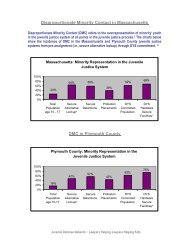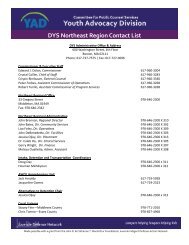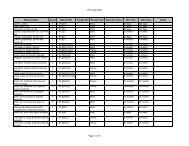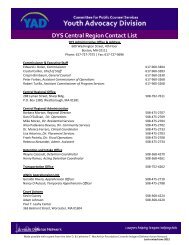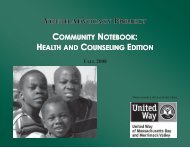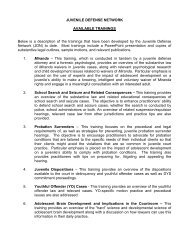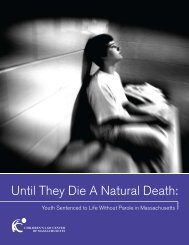States rethink 'adult time for adult crime' - the Youth Advocacy Division
States rethink 'adult time for adult crime' - the Youth Advocacy Division
States rethink 'adult time for adult crime' - the Youth Advocacy Division
Create successful ePaper yourself
Turn your PDF publications into a flip-book with our unique Google optimized e-Paper software.
What Makes Teens Tick; A flood of hormones, sure. But also a host of struct...plain <strong>the</strong> behaviors that make adolescence so exciting--and so exasperating<br />
life's work is nothing more than an attempt to establish a gigantic control group. "It<br />
turned out that normal brains were so interesting in <strong>the</strong>mselves," he marvels. "And<br />
<strong>the</strong> adolescent studies have been <strong>the</strong> most surprising of all."<br />
Be<strong>for</strong>e <strong>the</strong> imaging studies by Giedd and his collaborators at UCLA, Harvard, <strong>the</strong><br />
Montreal Neurological Institute and a dozen o<strong>the</strong>r institutions, most scientists<br />
believed <strong>the</strong> brain was largely a finished product by <strong>the</strong> <strong>time</strong> a child reached <strong>the</strong> age<br />
of 12. Not only is it full-grown in size, Giedd explains, but "in a lot of psychological<br />
literature, traced back to [Swiss psychologist Jean] Piaget, <strong>the</strong> highest rung in <strong>the</strong><br />
ladder of cognitive development was about age 12--<strong>for</strong>mal operations." In <strong>the</strong> past,<br />
children entered initiation rites and started learning trades at about <strong>the</strong> onset of<br />
puberty. Some <strong>the</strong>orists concluded from this that <strong>the</strong> idea of adolescence was an<br />
artificial construct, a phenomenon invented in <strong>the</strong> post--Industrial Revolution years.<br />
Giedd's scanning studies proved what every parent of a teenager knows: not only is<br />
<strong>the</strong> brain of <strong>the</strong> adolescent far from mature, but both gray and white matter undergo<br />
extensive structural changes well past puberty. "When we started," says Giedd, "we<br />
thought we'd follow kids until about 18 or 20. If we had to pick a number now, we'd<br />
probably go to age 25."<br />
Now that MRI studies have cracked open a window on <strong>the</strong> developing brain,<br />
researchers are looking at how <strong>the</strong> newly detected physiological changes might<br />
account <strong>for</strong> <strong>the</strong> adolescent behaviors so familiar to parents: emotional outbursts,<br />
reckless risk taking and rule breaking, and <strong>the</strong> impassioned pursuit of sex, drugs and<br />
rock 'n' roll. Some experts believe <strong>the</strong> structural changes seen at adolescence may<br />
explain <strong>the</strong> timing of such major mental illnesses as schizophrenia and bipolar<br />
disorder. These diseases typically begin in adolescence and contribute to <strong>the</strong> high<br />
rate of teen suicide. Increasingly, <strong>the</strong> wild conduct once blamed on "raging<br />
hormones" is being seen as <strong>the</strong> by-product of two factors: a surfeit of hormones,<br />
yes, but also a paucity of <strong>the</strong> cognitive controls needed <strong>for</strong> mature behavior.<br />
In recent years, Giedd has shifted his focus to twins, which is why <strong>the</strong> Manns are<br />
such exciting recruits. Although most brain development seems to follow a set plan,<br />
with changes following cues that are preprogrammed into genes, o<strong>the</strong>r, subtler<br />
changes in gray matter reflect experience and environment. By following twins, who<br />
start out with identical--or, in fraternal twins, similar--programming but <strong>the</strong>n diverge<br />
as life takes <strong>the</strong>m on different paths, he hopes to tease apart <strong>the</strong> influences of<br />
nature and nurture. Ultimately, he hopes to find, <strong>for</strong> instance, that Anthony Mann's<br />
plan to become a pilot and Brandon's to study law will lead to brain differences that<br />
are detectable on future MRIs. The brain, more than any o<strong>the</strong>r organ, is where<br />
experience becomes flesh.<br />
Throughout <strong>the</strong> afternoon, <strong>the</strong> Mann bro<strong>the</strong>rs take turns completing tests of<br />
intelligence and cognitive function. Between sessions <strong>the</strong>y occasionally needle one<br />
ano<strong>the</strong>r in <strong>the</strong> waiting room. "If <strong>the</strong> o<strong>the</strong>r person is in a bad mood, you've got to<br />
provoke it," Anthony asserts slyly. Their mo<strong>the</strong>r Nancy Mann, a sunny paragon of<br />
patience who has three daughters in addition to <strong>the</strong> five boys, smiles and rolls her<br />
eyes.<br />
Shortly be<strong>for</strong>e 5 p.m., <strong>the</strong> Manns head downstairs to <strong>the</strong> imaging floor to meet <strong>the</strong><br />
magnet. Giedd, a trim, energetic man with a reddish beard, twinkly blue eyes and an<br />
impish sense of humor, greets Anthony and tells him what to expect. He asks<br />
Anthony to remove his watch, his necklace and a high school ring, labeled KEEPER.<br />
Does Anthony have any metal in his body Any piercings Not this clean-cut, soccerplaying<br />
Mormon. Giedd tapes a vitamin E capsule onto Anthony's left cheek and one<br />
in each ear. He explains that <strong>the</strong> oil-filled capsules are opaque to <strong>the</strong> scanner and<br />
will define a plane on <strong>the</strong> images, as well as help researchers tell left from right. The<br />
scanning will take about 15 minutes, during which Anthony must lie completely still.<br />
Dressed in a red sweat shirt, jeans and white K-Swiss sneakers, he stretches out on<br />
<strong>the</strong> examining table and slides his head into <strong>the</strong> machine's giant magnetic ring.<br />
MRI, Giedd points out, "made studying healthy kids possible" because <strong>the</strong>re's no<br />
radiation involved. (Be<strong>for</strong>e MRI, brain development was studied mostly by using<br />
file:///L|/JDN/Brain%20Resources/Brain%20Developmen...iling%20Packet/8.%20What%20Makes%20Teens%20Tick.htm (2 of 8)8/16/2006 4:44:18 PM





